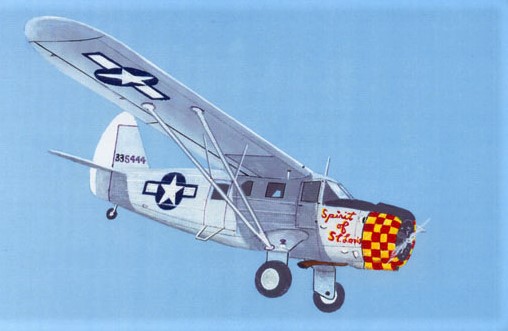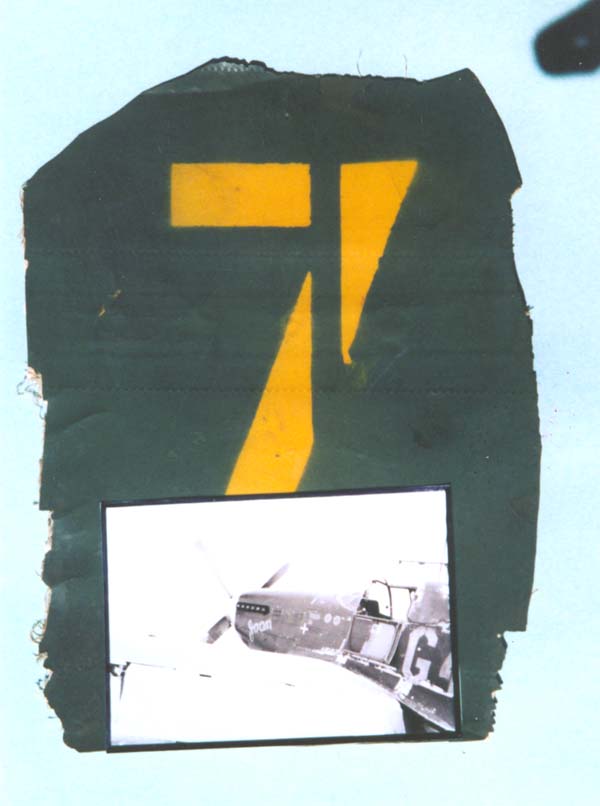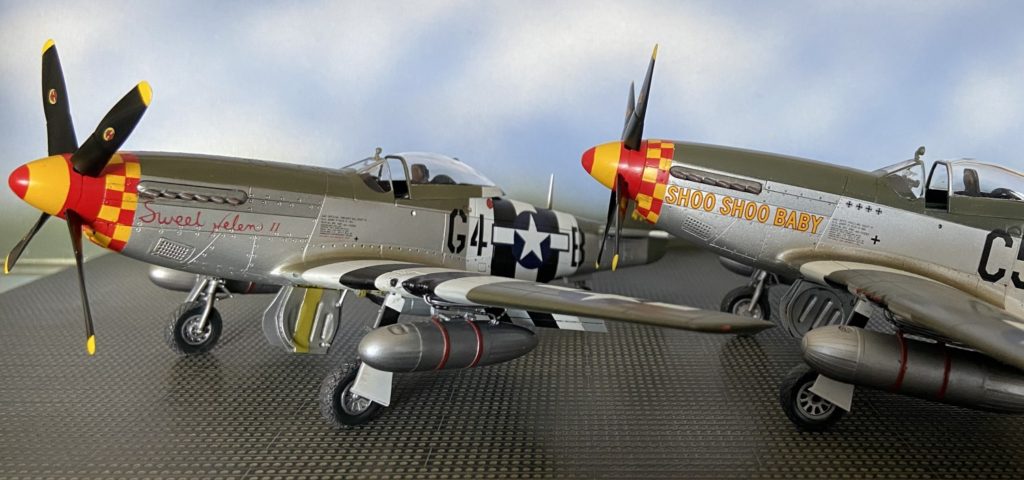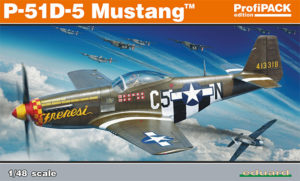
UC-64 Norseman art by Merle Olmsted
357th FG P-51 Model Builder’s Guide
Various historical hints, tips, and first hand information to assist modelers looking to accurately depict 357th aircraft.
The first P51 with Old Crow on the side was under the exhaust stacks. The very first P51 Old Crow was lost on a combat mission with Alfred Boyle at the controls. It was P51B-5-NA s/n 43-6723. The color scheme was solid olive drab with white nose and white stripes around the wings and tail. All 8th AF fighters had this scheme at that time. The squadron markings were B6-S. The small Old Crow was stenciled on the engine cowling just below the engine exhaust stacks on the left hand side only. There is a photo showing this airplane in my book To Fly & Fight in the photo section. I had another P51B -7NA for a short while s/n 43-12315 (Which was lost with Lt Carter Jones) then the more well known P51B-15NA s/n 43-24823 with the malcolm hood. The second tour P51D-10NA s/n 44-14450 Old Crow is also well known and documented. This is the best information that can be found anywhere. Bud Anderson

To attempt to show the color of OD Green used on operational aircraft, Merle Olmstead shared this patch of fabric from crashed P-51 “Joan” on which he was crew chief.
Ed Simpson’s P51 was B6-L and a P51B 42-106783. Eddie probably never got a D model as they were just starting to come into the squadron in June 44. I could have had maybe the 3rd one, but turned it down since I was so close to finishing and had all the bugs worked out of my B model. He was going to finish his tour in July and I figure that he was still low in the pecking order and further may have followed my example even if offered a D. We were getting sliver aircraft in that time period. The Flying Panther was assigned to Kit Carson and when the paper work arrived and the story behind the Flying Panther became known, it was turned over to Eddie Simpson, because he was from E Orange, NJ, and it was the school kids there that “bought” the P51 with bond sales and put the name on it. It even might have been re-painted in a camo scheme, but was probably left like it was shown. You have the kills right, 4 1/4. Bud Anderson
My P-51B serial number 823, the one with the malcolm hood, was inherited by Bill Overstreet and repainted Berlin Express after I finished my first tour and went home for R & R. I noticed it on a list of 357th airplanes and pilots who went on the Russian shuttle mission in July 44. I am not positive, but I think that later it was used by our 357th Clobber Collage pre-combat training unit, when we finally got P51Ds for everyone in the squadron. I do not know its final disposition was, nor do I know what happen to my D model after I left in Jan 45. Bud Anderson (Note. We now know the D Old Crow became Pretty Pix, flown by James Taylor)
The idea of using the yellow and red like the nose markings is good but it didn’t happen at that time. As I remember, the disc was white, the horse was brown, the plane in the painting was black. White edging was used on dark colors and black edging on light background. I don’t remember any yellow or red on that painting. Are you familiar with AeroMaster Decals of Miami? They had decals of the name and locomotive and B6-O some years ago but nothing on the right side. The BERLIN EXPRESS was all slanted on some of my planes and EXPRESS only on some. Sure wish I had saved more pictures. Anyway, I hope this is of some help. Bill Overstreet
Some history, my first P-51 was named SOUTHERN BELLE. It was damaged on an early mission and was replaced. By then we were going to Berlin regularly, so it was BERLIN EXPRESS. Only the express was slanted and no train or horse. The next one had both names slanted and the train added. When your Father returned to the States, I took his plane and this is the one that had the horse added. When I left, Bill Fricker took it and changed the name but kept the horse. All of my planes had red wheels and white sidewalls. Bill Overstreet
Kit Carson passed away March 8 1994, and was buried in Chester California. He died of natural causes. He was four days short of age 71. I attended the services along with one other 357th member Merle Olmsted. He got out of the Air Force and went to college and got an engineering degree. He went back into the Air Force and retired as a Colonel. He became somewhat of a recluse and did not regularly attend our 357th reunions. We did get him to come to Oshkosh in 1992 when EAA honored the aces of the 357th. He was the leading ace of the 357th and a great pilot. His book is one of the better WW II pilot books. He is mention in several books that list aces. One that comes to mind is the Osprey Aircraft of the Aces #1 Mustang aces of the 8th AF. There are no photos but a couple of pages about him. I am sure there are others but I would have to research that to be sure. The only currently available video is Mustang Magic. There may be another EAA video from 92′ What else can I tell you, he was a great guy but he avoided publicity and the public and people respected his privacy. Merle Olmsted’s book is still available “The 357th over Europe.” Carson is mention a lot in that one. Kit Carson’s book though out of print is a great source of information on the 357th FG and the P-51 Mustang. Bud Anderson
One thing I’ve noticed about many of the 357th Mustangs is that many of them, especially the later P-51Bs were painted in the field at unit level . Take for instance your Father’s last B model, a B-15 . As you can see, the canopy framing is natural metal. The reason for such is that in late 1943, Army Air Force planes were leaving the factory in Natural Metal Finnish, his bird being no exception. If you take a look at one of Jeff Ethel’s books , you will see a P-51C model named “Lil Kitten”. This Mustang started out life unpainted, was painted in the field O.D., had its upper surface invasion stripes overpainted in what looks to be Medium Green. As for British paints being used, my guess is that the 357th used anything that resembled green /Olive Drab that its crew chiefs could lay their hands on . I really love the P-51s of the 357th for this very reason, being that so many are a hodge-podge of O.Ds and various greens. In other words pick just about any green within reason that you want to use. Model Builder John Swearingen
This information was given by Bud in response to a question about fuselage invasion stripes on his P-51B. Sometime in July 1944 the word came down to remove the stripe from the upper surfaces. (per Merles first book) I completed my last mission of my first tour on July 11. I do not recall if I flew the B model Old Crow with the upper stripes removed or not. It is probably unlikely that I did. When the upper stripes were removed you can find anything you want as an example, some went half way up the side of the fuselage to the top of the bar in the the star and bar insignia and others went up to the bottom of the star and bar. If he likes it with the stripes half way up go ahead, who is to say it is actually wrong?? But to be sure that it is historically accurate, I would suggest that he stick to the full invasion stripes. Bud Anderson
363rd Fighter Squadron Patch. The only thing I remember was that we somehow came up with a squadron insignia while at Tonapah. It had a skull and a grim reaper type sickle or scythe. There was a Japanese rising sun flag in one eye and a swastika in the other. We actually started painting the insignia on some of the aircraft and made up hand painted leather patches for jackets. The paper work was sent some where to get it approved and much later it came back disapproved. The policy was that there were to be no national symbols in any squadron insignias. They furnished us an approved alternative with the skull and dagger that we are familiar with today as the 363rd insignia. I have no idea who came up with any of the designs. It would be natural to hear discussions about insignias as early as Hamilton Field since we were a completely new unit with no heritage. I know that we had and used the insignia at Tonapah. What the original insignia mean to me was death to the bad guys. My official USAF book on “Combat Squadrons of the Air Force World War II” says that none of the 357th squadrons had an emblem!! That does not mean they are right. Our entire unit was deactivated after WW II and our history was passed to the Ohio Air National Guard in 1946.
Bud Anderson
A common error in many profiles of 357th FG Mustangs or models made or them, is the addition of the wire antenna running from the rudder to the cockpit. This is inaccurate, as all 357th FG Mustangs (and probably all 8th AF Mustangs) used the SCR 522 radio (or equivalent), which used only the stub antenna. Merle Olmsted
The Army Air Corp had very poor equipment at the beginning of WW II. The helmet and goggles fit poorly and did not adapt well to an oxygen mask. In particular the early helmets fit poorly around the ears and hindered good radio reception. We used oxygen masks on 100% of our flights and it was a delight to get the form fitting seal around your ears that improved hearing greatly. Once we used the RAF helmet for awhile we did not want to change. We saw the new equipment as replacement pilots were assigned to our unit. You seldom used the goggles for anything so the RAF angled goggles were fine. Vision was not a problem even if you pulled them down over your eyes. The new AAF helmet and goggles were fine too. They had the same good fit around the ears and the goggles were fine if you ever needed them down over your eyes. I would have used the new AAF issue stuff but was happy with what I had and did not want to change or break in something new. I think that the other pilots wearing the RAF helmets probably felt the same way. Bud Anderson
There are no P-51D model kits on the market without the fin fillet, with either the Tamiya or Hasegawa you have to sand off the fillet before you put the fuselage halves together. It’s pretty easy to see where you want the new line to end up. Erik Whipple The Hasegawa kit is the easiest to convert, having a solid fillet that can just be carved out and smoothed over. The Tamiya kit has a hollow fillet. Ultracast makes a tail for the Tamiya kit, but you also need the early radios and gun sights for a D-5, which neither kit has. Scott Brown UPDATE! Airfix has one out It’s actually a very nice model and in my opinion, just as nice if not better in some ways than the Tamiya kit that’s been out since the early 90’s. My only main gripe about the Airfix D (they also do a D WITH the fin fillet) is the 108 gallon paper tanks are quite undersized, especially when comparing them to the tanks that come in the Tamiya (and other) kits. When sitting by itself it’s not really that noticeable, but if you sit a Tamiya and Airfix D next to each other and mount the paper tanks on both, then you can easily notice how undersized the Airfix tanks are. John Greiner

Airfix Kit – Left, Tamiya Kit – Right
The 357th flew every Merlin powered version of the P-51 produced during the war, from the B/C to the D/K. The first P-51Ds to arrive at Leiston probably were assigned the 2nd week of June 1944. They were P-51D-5s. These aircraft lacked the dorsal tail fillet extension of the later models. While it replicated the very pleasing lines of the P-51B, the addition of the bubble canopy replacing the high sided fuselage created some lateral instability that was thought to be detrimental in combat under high G and high angles of attack. For many years the only way to portray a 1/48 scale P-51D-5 model was to modify an existing later version kit and remove the fillet or use an aftermarket conversion. In 2019 Eduard produced a series of P-51Ds that included a dedicated D-5 version. This is now considered the most accurate 1/48 P-51D available. Scott Brown
There have been volumes written regarding the field applied green/gray camouflage applied to 357th FG aircraft, so no attempt to duplicate that here. The best information suggests that the aircraft were painted using RAF supplied stocks of Dark Green and Medium Sea Grey in accordance with a directive that the group was going to be deployed to the European continent after the invasion, and required some topside camouflage. This does not suggest that the question has been resolved…or will ever be resolved, so you get to choose your own colors. Approximate RAF colors were used on the profiles because I had to pick SOME color, but this is not the last word on the subject by any means. Many researchers believe Olive Drab and Neutral Gray were used, and there is a school of thought that both US and RAF colors were used. These aircraft were generally waxed by their ground crews to maximize speed. Most pictures show a reflective surface in the green areas. Scott Brown
Stencils were mostly over painted, but if you choose to use some, both the Eduard kit and Fundekals have excellent stencils. Scott Brown
Please check out Scott Brown’s Bullseye 357th FG Yoxford Boy P-51 decals.
If you have tips or comments please contact Jim Anderson at toflyandfight@gmail.com We are still developing this Guide.


